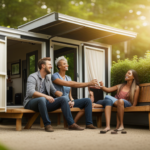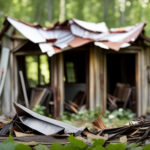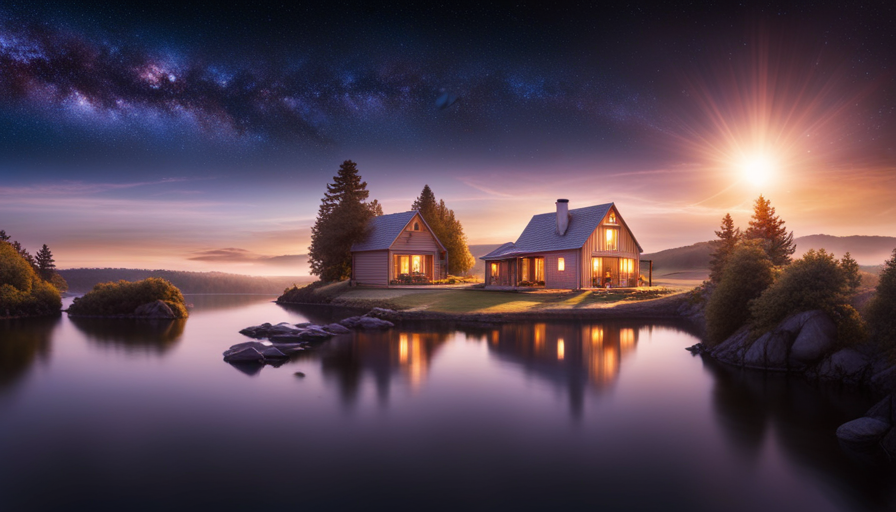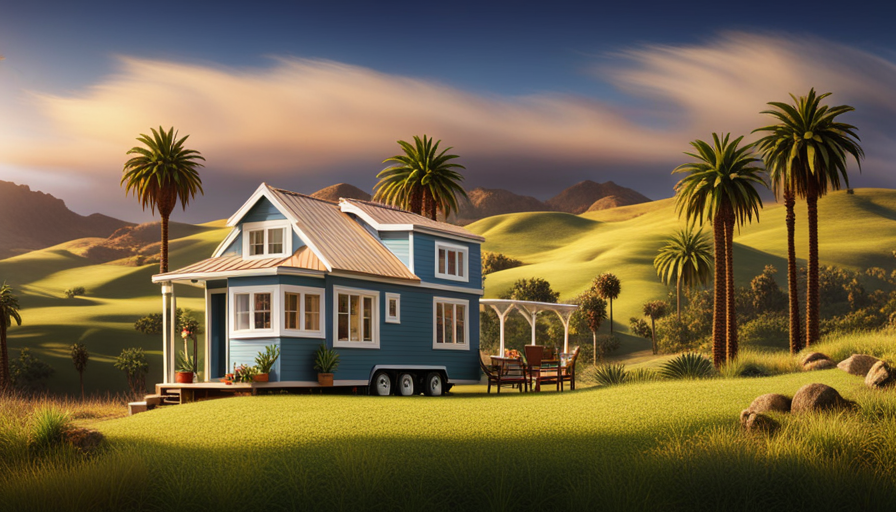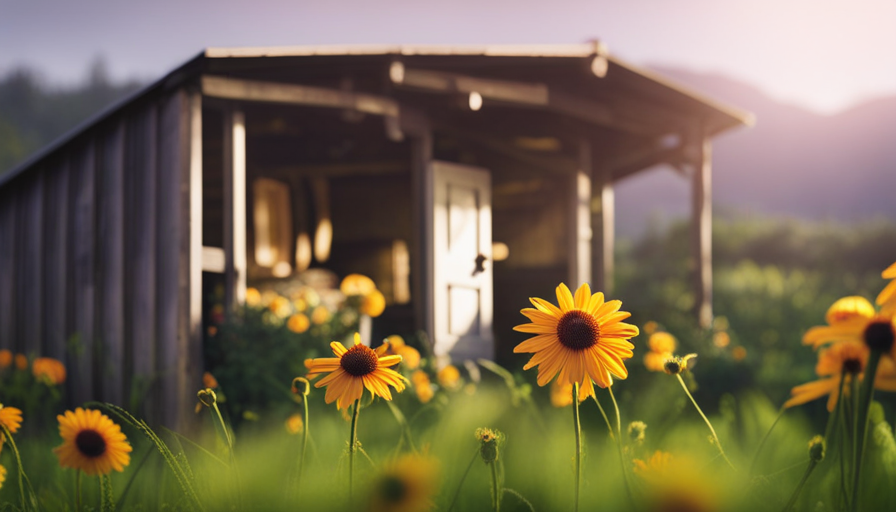Beginners Guides
Tiny House Nation Where Are They Now Stephanie

Welcome to the captivating world of ‘Tiny House Nation,’ where dreams of downsizing and simplifying become a reality. In this article, we delve into the life of Stephanie, a remarkable individual whose journey through tiny house living has left an indelible mark on her life.
Join me as we explore Stephanie’s reflections on the challenges and rewards of living in a tiny home, as well as her new adventures and achievements since appearing on the show. With Stephanie’s invaluable tips and advice, we gain insight into the importance of community and support in the tiny house movement.
Furthermore, we delve into Stephanie’s thoughts on sustainable living and the environmental impact of tiny homes. Finally, we uncover Stephanie’s future plans and goals within the tiny house movement.
Get ready to be inspired as we discover where Stephanie is now in her extraordinary tiny house journey.
Key Takeaways
- Stephanie’s journey through tiny house living has been filled with challenges and rewards, showcasing the transformative power of downsizing and simplifying.
- She emphasizes the importance of community and support in the tiny house movement, finding shared experiences and a sense of belonging among enthusiasts.
- Stephanie is passionate about sustainable living and making conscious choices to minimize her ecological footprint, advocating for renewable energy, water conservation, and a minimalist lifestyle.
- Since appearing on the show, Stephanie has achieved significant milestones, including starting a minimalist lifestyle blog, speaking at conferences, and writing a book, inspiring others to embrace simplicity and sustainability.
Stephanie’s Tiny House Journey on ‘Tiny House Nation’
You’ll be amazed at Stephanie’s incredible journey as she takes you inside her charming tiny house on ‘Tiny House Nation’.
Stephanie’s decision to downsize and simplify her life had a profound impact on her overall well-being. By embracing the tiny house movement, Stephanie was able to declutter her life and focus on what truly mattered. The benefits of simplifying were evident as she experienced a newfound sense of freedom and contentment.
Living in a tiny home allowed Stephanie to prioritize experiences over material possessions, leading to a more fulfilled and meaningful life. The impact of downsizing was not only evident in Stephanie’s physical space but also in her mental and emotional state. She discovered that less truly is more and found joy in the simple pleasures of life.
Now, let’s delve into the impact of living in a tiny home on Stephanie’s life, and how it has transformed her in ways she never imagined.
The Impact of Living in a Tiny Home on Stephanie’s Life
Once immersed in the coziness of my new abode, life took on a kaleidoscope of possibilities, transforming my perspective and inviting me to embrace a world of simplicity and contentment.
Living in a tiny home has profoundly impacted my relationships and financial freedom. There is no room for unnecessary clutter or distractions in a small space, allowing me to focus on what truly matters – the people I love and the experiences we share.
The close quarters have brought my loved ones and me closer together, fostering a deeper connection and enhancing our bond. Additionally, the financial freedom that comes with tiny living has been liberating.
With reduced expenses and fewer bills to worry about, I have saved money, pursued my passions, and lived a more fulfilling life.
Reflecting on my journey of downsizing and simplifying, I realize it has been a transformative and empowering experience, enabling me to prioritize what truly matters.
Stephanie’s Reflections on Downsizing and Simplifying
As I reflect on my journey of downsizing and simplifying, I can’t help but feel a sense of empowerment and liberation. Living in a tiny home has had a profound impact on my mental health. The simplicity and minimalism of my space have allowed me to declutter my mind and find peace.
Without the constant distractions of excess belongings, I’ve been able to focus on what truly matters to me. Additionally, the financial benefits of tiny house living have been tremendous. With a significantly reduced mortgage and lower utility bills, I’ve been able to save money and live a more financially stable life.
Transitioning into the challenges and rewards of tiny house living, I’ve encountered obstacles, but the rewards have far outweighed them.
The Challenges and Rewards of Tiny House Living
Navigating the path of downsizing and simplifying comes with its fair share of obstacles and rewards. Living in a tiny house has its challenges, but the rewards far outweigh them.
One of the biggest challenges is adapting to limited space. It requires creativity and clever storage solutions to make the most of every inch. Financial considerations also play a role, as tiny house living can significantly reduce expenses. The building and design process can be daunting, but the end result is a beautiful, personalized space.
Embracing a minimalist lifestyle has had a profound impact on my well-being. I feel lighter and more connected to nature. Living in a tiny house has taught me to appreciate the simpler things in life.
Transitioning to the next section, my new adventures and achievements since the show have been life-changing.
Stephanie’s New Adventures and Achievements Since the Show
Embarking on new adventures and achieving remarkable milestones, my life has been transformed since my appearance on the show.
In terms of career advancements, I’ve taken the lessons I learned from living in a tiny house and applied them to my professional life. I’ve started my own minimalist lifestyle blog, sharing my experiences and tips with others who’re interested in simplifying their lives.
This has opened up opportunities for me to speak at conferences and even write a book about my journey.
On a personal level, I’ve experienced tremendous growth. Living in a tiny house taught me to prioritize experiences over material possessions, and I’ve embraced this philosophy wholeheartedly. I now focus on creating memories and building relationships rather than accumulating stuff.
Transitioning into the next section, my perspective on material possessions has completely shifted.
How Stephanie’s Perspective on Material Possessions Has Changed
Imagine how your life could change if you shifted your perspective on material possessions and focused on what truly matters. That’s exactly what happened to me after appearing on ‘Tiny House Nation.’ My time on the show made me realize that changing priorities and embracing a minimalist lifestyle can bring immense joy and freedom. Here are five ways my perspective on material possessions has transformed:
-
I prioritize experiences over things: Instead of buying more stuff, I now invest in creating memories through travel and adventures.
-
I appreciate the beauty of simplicity: Living in a tiny house taught me to find joy in the small things and appreciate the simplicity of life.
-
I value relationships over material wealth: Building strong connections with loved ones has become my top priority, rather than accumulating material wealth.
-
I focus on sustainability: I’ve become passionate about reducing my environmental footprint and living a more sustainable lifestyle.
-
I feel lighter and happier: Letting go of unnecessary possessions has brought a sense of freedom and happiness that I never thought possible.
Transitioning into the next section, I want to share my tips and advice for those considering tiny house living.
Stephanie’s Tips and Advice for Those Considering Tiny House Living
Transitioning into the next section, you may find it valuable to consider Stephanie’s insightful tips and advice for those contemplating the prospect of embracing a minimalist lifestyle in a compact dwelling.
One of Stephanie’s key tips for tiny house living is to prioritize organization. With limited space, it’s essential to find creative ways to store your belongings and keep things tidy. Utilizing vertical storage, investing in space-saving furniture, and implementing clever storage solutions can help maximize the limited square footage.
Stephanie also emphasizes the importance of decluttering regularly to prevent the accumulation of unnecessary items. Additionally, she suggests embracing a minimalist mindset and being intentional about what you bring into your tiny house. By focusing on quality over quantity, you can ensure that every item serves a purpose and brings joy.
As we delve into the subsequent section about the importance of community and support in Stephanie’s tiny house journey, we’ll see how these principles have influenced her overall experience.
The Importance of Community and Support in Stephanie’s Tiny House Journey
Cultivating connections and seeking support from like-minded individuals has been a crucial component of fostering fulfillment and friendship throughout my tiny house journey. The importance of community and support can’t be overstated. Here are some reasons why:
-
Shared experiences: Being part of a community of tiny house enthusiasts allows for the exchange of ideas, tips, and stories. It’s comforting to know that others have faced similar challenges and triumphs.
-
Emotional support: Living in a tiny house can sometimes feel isolating. Having a supportive community provides a sense of belonging and understanding.
-
Resource sharing: From finding the best materials to navigating zoning regulations, a community can offer valuable resources and guidance.
-
Collaboration opportunities: Working together on projects or organizing events fosters a sense of unity and purpose.
Transitioning into the next section, the importance of community and support has also influenced my thoughts on sustainable living and the environmental impact of tiny house living.
Stephanie’s Thoughts on Sustainable Living and Environmental Impact
By embracing sustainable living practices and considering the environmental impact, I believe we can significantly reduce our carbon footprint and promote a greener future.
Throughout my journey on Tiny House Nation, I’ve become increasingly aware of our choices’ impact on the environment.
Living in a tiny house has allowed me to minimize my ecological footprint by utilizing renewable energy sources, implementing water conservation methods, and adopting a minimalist lifestyle. I’ve also been passionate about recycling, composting, and using eco-friendly products.
By making conscious choices, we can all contribute to a more sustainable world. As I continue my involvement in the tiny house movement, I hope to inspire others to embrace sustainable living and work towards a future where our actions positively impact the environment.
My future plans and goals revolve around further advocating for sustainable practices and promoting community engagement in the tiny house movement.
The Future Plans and Goals of Stephanie in the Tiny House Movement
Embracing sustainable practices and promoting community engagement in the tiny house movement is at the forefront of my future plans and goals. Here are three key things I hope to achieve:
-
Expand Sustainability: I’m dedicated to finding innovative ways to make tiny houses even more environmentally friendly. I’m implementing solar power systems and incorporating rainwater harvesting techniques to ensure that my tiny house is as sustainable as possible.
-
Educate Others: One of my main goals is to educate others about the benefits of the tiny house movement. I want to inspire people to downsize, live more sustainably, and embrace a simpler way of life. I’m conducting workshops, seminars, and using online platforms to spread awareness and provide resources to support those interested in joining the movement.
-
Foster Community: Building a strong and supportive community is crucial in the tiny house movement. I envision organizing meetups, creating online forums, and hosting events where like-minded individuals can come together, share ideas, and support one another on their tiny house journeys.
By focusing on these future plans and goals, I hope to make a meaningful impact in the tiny house movement and contribute to a more sustainable and connected world.
Frequently Asked Questions
How did Stephanie decide to participate in the show ‘Tiny House Nation’?
Stephanie’s motivation to participate in the show ‘Tiny House Nation’ was fueled by a burning desire for simplicity and freedom. She yearned for a life unburdened by excessive possessions and mortgage payments.
The show presented an opportunity for Stephanie to showcase her creativity and resourcefulness while also sharing her unique experience with the world. It allowed her to inspire others to embrace a minimalist lifestyle and find joy in the little things.
What were some of the unexpected challenges Stephanie faced while living in a tiny home?
Living in a tiny home presented me with some unexpected challenges. The limited space required me to downsize my belongings significantly, which was a difficult adjustment. Simple tasks like cooking and cleaning became more complicated due to the lack of counter space and storage.
I also had to get creative with storage solutions to maximize the available space. Despite these challenges, my experience living in a tiny home taught me valuable lessons about minimalism and the importance of prioritizing what truly matters.
How has Stephanie’s relationship with her possessions changed since downsizing and simplifying?
Embarking on Stephanie’s minimalism journey was like stepping into a new world, full of possibilities and freedom. It was a bittersweet farewell to the cluttered past, but one that brought immense clarity.
Letting go of emotional attachment towards possessions proved to be the most challenging aspect. However, as I downsized and simplified, my relationship with my belongings transformed. Possessions no longer defined me, but rather, I found solace in the simplicity and the memories they held.
What advice does Stephanie have for individuals who are considering transitioning to tiny house living?
If you’re considering transitioning to tiny house living, I have some advice for you.
First, let’s address the benefits of tiny house living. It allows you to simplify your life, reduce your carbon footprint, and save money on utilities and maintenance.
Now, let’s debunk some common misconceptions about tiny house living. Contrary to popular belief, tiny houses can be comfortable and spacious if designed well.
Additionally, it’s important to remember that downsizing means letting go of unnecessary possessions, but the freedom and simplicity it brings is absolutely worth it.
What are Stephanie’s future plans and goals within the tiny house movement?
In the future, my plans and goals within the tiny house movement are focused on making a lasting impact on the community. I want to continue sharing my knowledge and experiences to inspire others to embrace the benefits of tiny house living.
By living in a smaller, more sustainable space, we can reduce our carbon footprint and contribute to a healthier environment. Together, we can create a more sustainable future for generations to come.
Conclusion
Well, who would’ve thought that living in a tiny house could’ve had such a profound impact on my life? It’s funny how downsizing and simplifying can actually lead to a greater sense of freedom and fulfillment.
I never imagined that my tiny house journey would’ve opened up so many new adventures and achievements for me. And let’s not forget the importance of community and support in this journey. It’s truly amazing how sustainable living and environmental impact have become such prominent themes in my life.
As for the future, the possibilities are endless in the tiny house movement. Who knows what incredible goals and plans await me? It’s a small world after all.
Hi, I’m Emma. I’m the Editor in Chief of Tiny House 43, a blog all about tiny houses. While tree houses are often associated with childhood, they can be the perfect adult retreat. They offer a cozy space to relax and unwind, surrounded by nature. And since they’re typically built on stilts or raised platforms, they offer stunning views that traditional homes simply can’t match. If you’re looking for a unique and romantic getaway, a tree house tiny house might just be the perfect option.
Beginners Guides
How Much Is A Tiny House In Texas
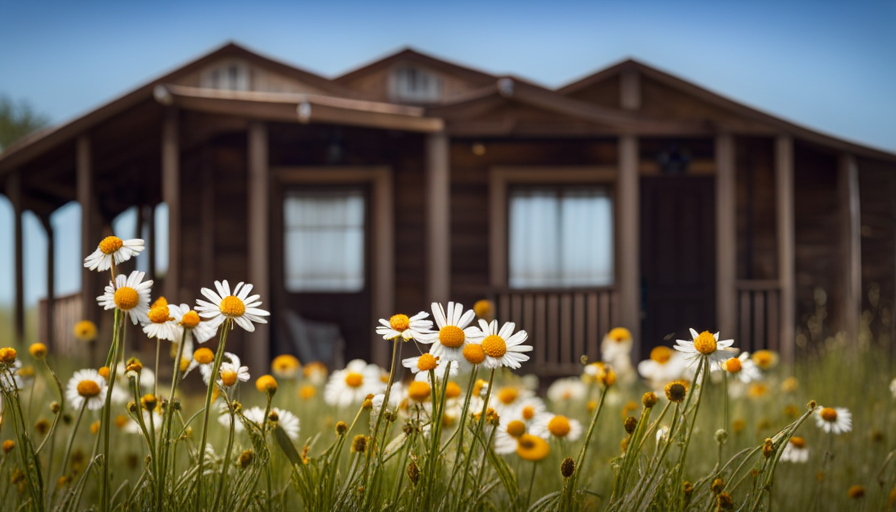
Interestingly, I was just looking into the pricing of tiny homes in Texas, and I must say, the choices available are truly captivating.
Living in a tiny house has become a popular trend, especially in a state like Texas where the vast landscapes and affordable living opportunities abound. As I delved into the subject, I discovered several factors that influence the cost of these pint-sized dwellings, ranging from location to size and amenities.
In this article, I will delve into the average price range for tiny houses in Texas, explore some affordable options, discuss financing and payment options, and provide tips on finding and buying a tiny house in the Lone Star State. Additionally, I will delve into the pros and cons of living in a tiny house and explore alternative housing options for those seeking a unique living experience in Texas.
So, if you’re curious about the cost of a tiny house in Texas, you’ve come to the right place. Let’s get started!
Key Takeaways
- The cost of a tiny house in Texas can vary depending on factors such as customization options, size, and location, with the average price range being $30,000 – $60,000.
- Texas offers a variety of affordable housing options, including pre-built houses, DIY kits, and tiny house communities, with financing options available such as upfront payment, loans, and rent-to-own.
- It is important to consider factors such as location, zoning regulations, and popular locations when buying a tiny house in Texas, as prices can range from $60,000 – $200,000 in cities like Austin, Dallas, Houston, and San Antonio.
- It is recommended to research reputable tiny house builders in the area and familiarize oneself with zoning regulations, which can be done by contacting local offices and joining online communities and forums.
Factors Influencing the Cost of Tiny Houses in Texas
If you’re looking to buy a tiny house in Texas, you’ll be amazed at how various factors can greatly impact the cost, making it an exciting and sometimes challenging journey to find your perfect affordable home.
One of the main factors that influence the cost of tiny houses in Texas is the level of customization options you choose. The more customized your tiny house is, the higher the price will be. This is because customization requires additional materials, labor, and design expertise, which all add up.
Another factor that affects the cost of tiny houses in Texas is the size of the house itself. Typically, the larger the tiny house, the higher the cost. However, it’s important to note that even though tiny houses are small by nature, they can still vary in size, ranging from around 100 to 400 square feet.
Additionally, the location of the tiny house can also influence its cost. If you choose to place your tiny house in a prime location or a highly desirable area, the cost may be higher due to the increased demand and property values.
Considering these factors, it’s crucial to carefully consider your budget and priorities when searching for a tiny house in Texas. Now, let’s delve into the average price range for tiny houses in Texas, where we’ll explore the different options available and help you find the perfect tiny house that fits your budget.
Average Price Range for Tiny Houses in Texas
On average, you can expect to pay a modest sum for a compact dwelling in the Lone Star State. The average price range for tiny houses in Texas falls between $30,000 and $60,000.
However, it’s important to note that this range can vary depending on various factors such as size, location, and amenities. Larger tiny houses with more luxurious features can command higher prices, while smaller and simpler models tend to be more affordable.
When considering the cost of a tiny house in Texas, it’s also worth exploring the options for affordable financing. Many tiny house builders in the state offer financing plans to help make the dream of owning a tiny house more attainable. These plans may include low down payments, favorable interest rates, and flexible repayment terms.
Furthermore, Texas is home to a thriving community of tiny house builders who specialize in creating affordable and high-quality dwellings. These builders are experienced in designing and constructing tiny houses that maximize space and functionality while keeping costs reasonable.
In the subsequent section about affordable tiny house options in Texas, we’ll delve deeper into the various choices available for those looking to embrace the tiny house lifestyle without breaking the bank.
Affordable Tiny House Options in Texas
There are numerous affordable options for those looking to embrace the tiny house lifestyle in Texas, with prices ranging from $20,000 to $40,000, making it an accessible choice for many individuals and families. Texas offers a wide selection of tiny houses at affordable pricing, ensuring that there is something for everyone’s budget.
Whether you’re a minimalist seeking a simpler way of life or a family looking to downsize and reduce expenses, Texas has a variety of available options to suit your needs.
One option is to purchase a pre-built tiny house from a reputable manufacturer. These houses often come with basic amenities and are ready for immediate occupancy.
Another option is to build your own tiny house. DIY kits are available at affordable prices, allowing you to customize and personalize your living space while saving money.
Additionally, there are tiny house communities in Texas that offer affordable housing options. These communities provide a sense of community and shared resources, making the tiny house lifestyle even more affordable.
When it comes to financing and payment options for tiny houses in Texas, there are various options available. Some individuals choose to finance their tiny houses through traditional loans, while others opt for alternative financing methods such as personal loans or crowdfunding.
Additionally, some tiny house manufacturers offer in-house financing options, making it easier for individuals to purchase their dream tiny home.
With the availability of affordable pricing and various financing options, embracing the tiny house lifestyle in Texas has never been more attainable.
Moving forward, let’s explore the financing and payment options for tiny houses in Texas.
Financing and Payment Options for Tiny Houses in Texas
With a variety of financing options available, Texans can easily turn their dreams of owning a cozy and affordable home into a reality. When it comes to financing a tiny house in Texas, there are several payment plans to consider. Whether you choose to pay upfront, take out a loan, or explore rent-to-own options, there is a solution that can fit your budget and lifestyle.
To help you navigate through the various financing options, here is a table outlining some of the most common choices:
| Financing Option | Description | Pros | Cons |
|---|---|---|---|
| Paying Upfront | Paying the full price of the tiny house upfront. | No interest or monthly payments. | Requires a significant amount of savings. |
| Tiny House Loans | Taking out a loan from a financial institution. | Allows for gradual payments over time. | Interest rates may be higher than traditional mortgages. |
| Rent-to-Own | Renting the tiny house with an option to purchase it in the future. | Low initial costs. | Limited selection of available tiny houses. |
Considering the financing options available, it’s important to also consider other factors when buying a tiny house in Texas, such as location, size, and mobility. By thoroughly evaluating these considerations, you can make an informed decision that aligns with your needs and preferences.
Considerations When Buying a Tiny House in Texas
When considering purchasing a tiny home in the Lone Star State, it’s essential to envision the perfect blend of charm, functionality, and affordability. Texas offers a variety of financing options for those looking to buy a tiny house. From traditional mortgages to personal loans, there are options available to fit different financial situations. It’s important to research and compare these options to find the best fit for your needs.
Additionally, it’s crucial to consider the zoning regulations in Texas before purchasing a tiny house. Each city and county may have different regulations regarding where you can park or build a tiny house. It’s important to ensure that the location you choose is in compliance with these regulations to avoid any potential legal issues.
When it comes to popular locations for tiny house living in Texas, there are plenty of options to choose from. From vibrant cities like Austin and Dallas to scenic areas like the Hill Country and Gulf Coast, Texas offers a wide range of environments to suit different preferences. Transitioning into the subsequent section about popular locations for tiny house living in Texas, it’s important to explore the different options available to find the perfect spot for your tiny home.
Popular Locations for Tiny House Living in Texas
Looking for the perfect spot to park your tiny home in the Lone Star State? Well, let’s explore some popular locations in Texas that are bound to capture your heart! Texas offers a wide range of options for tiny house living, from bustling urban areas to serene countryside settings. Here are some popular locations and their average price ranges:
| Location | Average Price Range |
|---|---|
| Austin | $100,000 – $200,000 |
| Dallas | $80,000 – $150,000 |
| Houston | $70,000 – $120,000 |
| San Antonio | $60,000 – $100,000 |
Austin, the state capital, is known for its vibrant music scene and eclectic culture. With an average price range of $100,000 to $200,000, it offers a mix of urban amenities and natural beauty. Dallas, a major metropolitan area, has an average price range of $80,000 to $150,000. It boasts a thriving arts district and a bustling downtown. Houston, the largest city in Texas, offers a diverse range of tiny house options with an average price range of $70,000 to $120,000. San Antonio, known for its rich history and vibrant riverwalk, has an average price range of $60,000 to $100,000.
Now that you know about some popular locations, let’s dive into tips for finding and buying a tiny house in Texas.
Tips for Finding and Buying a Tiny House in Texas
Ready to embark on your journey to find and purchase the perfect little slice of Texas living? When it comes to finding and buying a tiny house in Texas, there are a few key things to keep in mind.
First and foremost, you’ll need to find reputable tiny house builders in the area. Do your research, read reviews, and ask for recommendations from others who’ve gone through the process.
Next, it’s important to familiarize yourself with the zoning regulations for tiny houses in Texas. Each city and county may have different rules and restrictions, so make sure you’re aware of what’s allowed in your desired location.
In addition to these important considerations, here are a couple of sub-lists to help you navigate the process of finding and buying a tiny house in Texas:
-
Tips for finding a tiny house builder:
- Research different builders and their portfolios
- Visit tiny house communities or events to see their work in person
-
Tips for understanding zoning regulations:
- Contact local zoning offices for information on specific regulations
- Join online communities or forums to connect with others who’ve navigated the zoning process
Finding and buying a tiny house in Texas can be an exciting and rewarding experience. Once you’ve done your research and are familiar with the builders and zoning regulations, you’ll be well-prepared to make an informed decision.
Now, let’s explore the pros and cons of living in a tiny house in Texas.
Pros and Cons of Living in a Tiny House in Texas
Although there are both advantages and disadvantages to residing in a compact dwelling in the Lone Star State, the decision to live in a tiny house in Texas ultimately depends on individual preferences and lifestyle choices. Downsizing to a tiny house offers several benefits, such as reduced expenses and a smaller carbon footprint. With lower mortgage or rental costs, homeowners can save money and have more financial freedom. Additionally, living in a small space encourages minimalism and decluttering, leading to a simpler and less stressful lifestyle. However, there are also challenges to consider. One major obstacle is the zoning regulations for tiny houses in Texas. Many cities have restrictions on where these homes can be located, making it difficult to find suitable land. Furthermore, the limited space in a tiny house can pose challenges for storage and privacy. Despite these drawbacks, the tiny house movement continues to gain popularity in Texas, as it provides an affordable housing option for those looking to simplify their lives. In the next section, we will explore alternative housing options in Texas that can also meet the needs of individuals seeking a unique and cost-effective living situation.
Alternative Housing Options in Texas
When considering alternative housing options in Texas, there are several choices to explore.
One option is RV living, which offers the flexibility of being able to travel while still having a home base.
Container homes are another popular choice, as they’re affordable and eco-friendly.
Additionally, yurts and tiny cabins provide a unique and minimalist lifestyle, perfect for those seeking a simpler way of living.
RV Living
Living in an RV can be an affordable option, as you’ll save around 60% on housing expenses compared to traditional living arrangements. RV living offers a mobile lifestyle, allowing you to travel and explore different areas of Texas while still having a place to call home. It provides a sense of freedom and adventure, with the added benefit of reduced maintenance and utility costs.
Many RV parks in Texas offer various amenities such as laundry facilities, swimming pools, and community events, making it a sociable living experience. However, if RV living doesn’t suit your needs, another alternative housing option in Texas is container homes. These homes are made from recycled shipping containers and can be customized to fit your preferences. They provide a unique and eco-friendly housing solution and can be more cost-effective than traditional homes.
Container Homes
After exploring the world of RV living, let’s dive into another fascinating alternative housing option: container homes. These unique dwellings have gained popularity in recent years, offering a modern and eco-friendly twist to traditional homes.
Container homes are made from shipping containers that are repurposed into living spaces. They provide a cost-effective solution for those seeking affordability and sustainability. In Texas, container homes can range in price from $20,000 for a basic setup to $150,000 for a more luxurious design. The cost varies depending on factors such as size, customization, and location.
With their modular design, container homes offer flexibility and can be easily transported or expanded.
Now, let’s transition into the next section where we’ll explore the enchanting world of yurts and tiny cabins.
Yurts and Tiny Cabins
Yurts and tiny cabins offer a charming escape, inviting individuals to immerse themselves in the simplicity and tranquility of nature.
Yurts, originally used by nomadic tribes, have become popular options for those seeking a unique and eco-friendly living space. These circular structures feature a lattice framework covered with fabric, providing a cozy and spacious interior. Yurts are often constructed using sustainable materials such as bamboo or reclaimed wood, making them environmentally friendly.
On the other hand, tiny cabins are small, rustic dwellings that blend seamlessly into natural surroundings. These cabins are typically built with minimal impact on the environment, using sustainable construction methods and materials. They offer a cozy retreat and can be customized to fit the needs and preferences of the owner.
From yurts to tiny cabins, there are various options available for those who desire a simpler way of living close to nature. When searching for a tiny house in Texas, there are several resources and websites that can help you find the perfect home.
Resources and Websites for Finding Tiny Houses in Texas
When searching for tiny houses in Texas, you can easily find various resources and websites that provide listings and information. These resources are helpful in finding the perfect tiny house that fits your needs and preferences. In addition to listings, these websites often offer valuable information on financing options and tiny house communities in Texas.
One popular website for finding tiny houses in Texas is "Tiny House Listings." This website allows you to search for tiny houses by location, size, and price range. It also provides a platform for sellers to list their tiny houses for sale. Another useful resource is "Tiny House Finder." This website offers a comprehensive directory of tiny house builders, communities, and events in Texas.
If you’re looking for financing options, "Tiny House Loans" is a great website to explore. It provides information on loans specifically designed for purchasing or building a tiny house. They offer resources and guidance on securing financing and understanding the loan process.
Overall, these resources and websites make it easier to find and navigate the world of tiny houses in Texas. Whether you’re interested in purchasing a tiny house or joining a tiny house community, these platforms are valuable tools to help you make informed decisions.
Frequently Asked Questions
Are there any specific zoning regulations or restrictions for tiny houses in Texas?
In Texas, there are specific zoning regulations and building codes that apply to tiny houses. These regulations vary depending on the location within the state.
Zoning regulations determine where tiny houses can be placed, such as in residential or mixed-use areas.
Building codes ensure that tiny houses meet safety and structural requirements.
It’s important to research and comply with these regulations before building or placing a tiny house in Texas to avoid any legal issues or penalties.
What are the maintenance costs associated with owning a tiny house in Texas?
Maintenance costs for a tiny house in Texas can vary depending on factors like size, materials used, and location. Generally, there are both pros and cons to consider.
On the positive side, tiny houses require less maintenance overall compared to larger homes. However, certain aspects like plumbing or electrical systems may need regular upkeep. Additionally, it’s important to budget for routine maintenance tasks such as painting, roof repairs, and pest control.
Overall, the maintenance costs of owning a tiny house in Texas can be manageable with proper planning and budgeting.
Can I customize the design and layout of a tiny house in Texas?
Absolutely! When it comes to building a tiny house in Texas, you have plenty of customization options and design flexibility. From choosing the layout and materials to adding unique features, the possibilities are endless. Whether you want a cozy rustic cabin or a sleek modern design, you can create a tiny house that reflects your personal style and needs.
The freedom to customize is one of the many advantages of owning a tiny house in Texas.
Are there any tax benefits or incentives for owning a tiny house in Texas?
There are indeed tax benefits and financial incentives for owning a tiny house in Texas. As a tiny house owner, you may be eligible for certain tax deductions. For example, you could potentially deduct the mortgage interest on your tiny house if it meets certain criteria.
Additionally, there may be financial incentives available, such as grants or programs aimed at promoting environmentally friendly housing options. These incentives can help offset the costs of owning and maintaining a tiny house.
Are there any specific insurance requirements for tiny houses in Texas?
Insurance coverage for tiny houses in Texas may vary depending on factors such as the size, location, and intended use of the house. It’s important to check with insurance providers to ensure adequate coverage.
Additionally, building codes play a crucial role in determining insurance requirements. Complying with local building codes can help in obtaining insurance and protecting against potential risks.
It’s advisable to consult with professionals to understand the specific insurance requirements for tiny houses in Texas.
Conclusion
In conclusion, the world of tiny houses in Texas is as vast as the Lone Star State itself. These small yet mighty abodes offer an alternative housing option that can fit a variety of budgets and lifestyles.
Like a wildflower blooming in a field, tiny houses have the power to bring simplicity, freedom, and a sense of adventure to those who choose to embrace them. So, whether you’re searching for a cozy retreat or a sustainable living solution, the tiny house market in Texas has something for everyone.
Explore, dream, and find your own little piece of paradise in the land where everything is bigger, but sometimes, smaller is better.
Hi, I’m Emma. I’m the Editor in Chief of Tiny House 43, a blog all about tiny houses. While tree houses are often associated with childhood, they can be the perfect adult retreat. They offer a cozy space to relax and unwind, surrounded by nature. And since they’re typically built on stilts or raised platforms, they offer stunning views that traditional homes simply can’t match. If you’re looking for a unique and romantic getaway, a tree house tiny house might just be the perfect option.
Beginners Guides
How Many Feet Long Is A Tiny House
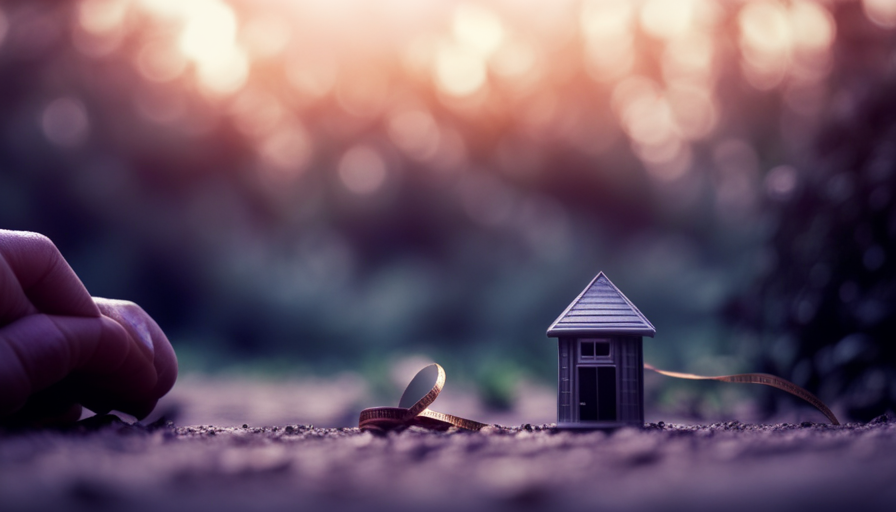
Have you ever pondered the maximum length of a tiny house? Allow me to provide an example to illustrate this point.
Imagine a cozy, yet compact, dwelling measuring only 200 square feet. Now picture another tiny house that stretches to a whopping 400 square feet! Quite a difference, isn’t it?
In this article, we will explore the fascinating world of tiny houses and delve into the question: ‘How many feet long is a tiny house?’
Tiny houses have gained immense popularity in recent years due to their minimalistic lifestyle appeal and affordability. These pint-sized dwellings come in various sizes, ranging from as little as 100 square feet up to around 400 square feet. However, when it comes to determining the length of a tiny house, there are several factors at play.
Join me as we uncover the maximum lengths of tiny houses, discover what influences their size restrictions, explore real-life examples of longer tiny houses, and discuss whether opting for a longer model might be the right choice for you.
Get ready for an enlightening journey through the dimensions of these charming abodes!
Key Takeaways
- Tiny houses can range in size from 100 to 400 square feet, but can be as small as 80 square feet or as large as 600 square feet.
- Many cities and towns have guidelines that limit the length of tiny houses to maintain aesthetics or prevent overcrowding.
- Building codes and regulations dictate the maximum dimensions allowed for a tiny house, including square footage and length.
- Longer tiny houses offer additional living space and flexibility in layout design, but may have higher costs and transportation limitations.
Overview of Tiny Houses
Tiny houses are designed to be compact and efficient living spaces. They are a popular housing option for those looking to downsize or live a more minimalist lifestyle. One of the defining features of a tiny house is its small size, typically ranging from 100 to 400 square feet. This maximum square footage allows for a minimalistic approach to living, with every inch of space carefully planned and utilized.
One of the advantages of tiny houses is their affordability compared to traditional homes. The cost comparison between a tiny house and a conventional house is significant, as tiny houses require fewer materials and less land. Additionally, the cost of utilities and maintenance for a tiny house is considerably lower.
Transitioning into the subsequent section about different sizes of tiny houses, it’s important to note that while the average size falls within the range mentioned earlier, there are variations in dimensions depending on individual preferences and needs. Some may opt for even smaller micro-homes under 100 square feet, while others might choose slightly larger models reaching up to 500 square feet. These variations in size allow individuals to customize their living space according to their specific requirements without compromising on the benefits that come with owning a tiny house.
Different Sizes of Tiny Houses
Looking for a compact living option? Have you ever wondered about the dimensions of those adorable small dwellings? Well, let me tell you about the different sizes of tiny houses.
Tiny houses come in various styles and sizes to suit different preferences and needs. The most common size ranges from 100 to 400 square feet, but they can also be as small as 80 square feet or as large as 600 square feet. The size of a tiny house depends on factors such as your lifestyle, budget, and local regulations.
When considering the size of a tiny house, it’s important to think about cost considerations as well. Generally, smaller homes are more affordable since they require fewer materials and less labor during construction. However, larger tiny houses can provide additional space for amenities and storage if that is important to you.
Now that you have an idea of the different sizes available for tiny houses, let’s explore the maximum length of these dwellings in the next section.
Maximum Length of Tiny Houses
The dimensions of compact dwellings can vary significantly, with the maximum length of these small abodes determined by factors such as local regulations and personal preferences. When it comes to tiny houses, building restrictions play a major role in determining their size. Many cities and towns have specific guidelines that limit the length of tiny houses in order to maintain a certain aesthetic or prevent overcrowding. These restrictions often range from 20 to 30 feet, although some areas may allow for longer structures with proper permits.
Another factor that influences the maximum length of tiny houses is the desire to create tight-knit communities. In many cases, tiny house communities are designed with shared spaces and amenities in mind. This means that individual homes must be kept within a certain size range to ensure that there is enough room for common areas and a sense of community.
Building restrictions and the goal of fostering community are two key factors that determine the maximum length of tiny houses. By adhering to local regulations and considering the needs of communal living, individuals can design their compact dwellings accordingly. Moving forward, let’s explore other factors that also come into play when determining the length of these unique homes.
Factors That Determine Tiny House Length
When determining the length of a tiny house, there are several key factors to consider.
First and foremost are building codes and regulations, which dictate the maximum dimensions allowed for a structure.
Secondly, transportation and mobility play a crucial role as tiny houses need to be able to be moved easily and safely.
Lastly, personal preferences and needs also come into play as individuals may have specific requirements or desires for their living space.
Overall, these factors must be carefully considered in order to determine the appropriate length for a tiny house.
Building Codes and Regulations
Building codes and regulations dictate the maximum number of feet a tiny house can be in order to ensure safety and compliance. When it comes to obtaining building permits for a tiny house, it’s crucial to adhere to these regulations. Here are three important factors regarding building codes and regulations:
-
Safety Regulations: Building codes set specific standards for structural integrity, fire safety, electrical systems, plumbing, and insulation. These regulations aim to protect occupants from potential hazards.
-
Maximum Square Footage: Building codes often limit the square footage of a tiny house to ensure that it remains within reasonable dimensions for transportation purposes.
-
Zoning Restrictions: Local zoning laws may impose additional restrictions on the size and placement of tiny houses based on their intended use or location within a particular community.
Considering these factors, it’s essential to navigate through the intricate web of building codes and regulations before starting construction on your tiny house. This understanding will help ensure a safe and compliant dwelling that you can transport easily without compromising its structure or mobility.
Transportation and Mobility
Transporting a tiny house requires careful planning and consideration of its size, weight, and mobility to ensure a smooth journey. The transportation challenges of a tiny house are primarily related to its dimensions. While the compact size makes it easier to navigate through narrow roads and tight spaces, it can also limit the living space inside.
Additionally, the weight of the tiny house must be within legal limits for safe transport. Pros of transporting a tiny house include the ability to move to different locations easily and the freedom to live in remote or off-grid areas. However, there are also cons to consider such as limited storage space for personal belongings and potential restrictions imposed by local regulations.
Transitioning into the subsequent section about personal preferences and needs, it is important to evaluate these transportation factors alongside individual desires for location independence and mobility.
Personal Preferences and Needs
One crucial aspect to consider when it comes to owning a tiny house is personal preferences and needs. Personal style plays a significant role in determining the size and design of a tiny house. Some individuals may prefer a minimalist approach with clean lines and open spaces, while others may lean towards a more eclectic style with vibrant colors and unique features.
Budget considerations also come into play when deciding on the length of a tiny house. A larger tiny house will generally cost more due to increased materials and construction expenses. Therefore, individuals with limited budgets may opt for a smaller footprint.
Taking personal preferences and budget constraints into account, it is essential to find the right balance between comfort, functionality, and affordability when choosing the length of a tiny house.
Moving on to the subsequent section about the average length of tiny houses…
Average Length of Tiny Houses
The average length of a tiny house is typically around 20 feet. However, it’s important to note that the size of a tiny house can vary depending on several factors. Factors affecting tiny house length include personal preferences and needs, zoning regulations, and transportation limitations.
When considering the length of a tiny house, it’s essential to take into account the pros and cons of different sizes. A smaller tiny house may be easier to tow and maneuver, making it ideal for those who frequently travel or move their homes. Additionally, a smaller size often means lower construction costs and maintenance expenses.
On the other hand, a larger tiny house provides more living space and allows for greater customization options. Choosing a longer tiny house offers numerous benefits. Firstly, it provides additional room for comfortable living arrangements such as separate sleeping areas or dedicated workspaces. Moreover, a longer footprint can accommodate larger appliances and furniture pieces without compromising functionality or aesthetics.
While the average length of a tiny house is typically around 20 feet, there are various factors that influence its size. Understanding the pros and cons of different sizes can help individuals make informed decisions when designing their own tiny houses without feeling restricted by predetermined norms or limitations in space.
Benefits of Choosing a Longer Tiny House
Opting for a longer tiny house grants you the luxury of additional living space, allowing you to create separate sleeping areas or dedicated workspaces that cater to your specific needs and desires. The benefits of choosing a longer tiny house are numerous and can greatly enhance your overall living experience.
One of the main benefits is the increased flexibility in layout design. With more square footage, you have the freedom to incorporate features like lofted bedrooms or a designated office area. This added space also allows for more storage options, making it easier to keep your belongings organized and accessible.
Considerations should be made when deciding on the length of your tiny house, as longer structures may require larger trailers or more substantial foundations. It’s essential to ensure that the land you plan on placing your tiny house can accommodate its length.
Additionally, longer tiny houses may come with higher costs associated with construction, transportation, and utilities. It’s crucial to weigh these expenses against the benefits offered by the extra space.
Transitioning into discussing challenges, despite these advantages, there are also some considerations when it comes to opting for a longer tiny house.
Challenges of Longer Tiny Houses
Despite the allure of spaciousness, navigating the challenges of extended tiny homes can feel like trying to swim against a relentless current. The longer the tiny house, the more obstacles one may encounter.
Here are some key challenges to consider:
-
Weight distribution: Longer tiny houses require careful attention to weight distribution, as uneven weight can lead to instability and potential safety hazards.
-
Transportation limitations: Longer tiny houses may face restrictions when it comes to transportation. Some roads have length limitations or tight turns that can make moving them difficult.
-
Cost implications: Building and maintaining longer tiny houses often come with higher costs. From construction materials to utility expenses, these financial considerations should not be overlooked.
Overcoming these challenges requires creative design ideas that address both practical and aesthetic concerns. By incorporating multifunctional furniture, such as foldable tables or hidden storage compartments, space utilization can be maximized efficiently. Additionally, implementing smart technology for energy management and space optimization can further enhance the functionality of longer tiny houses.
With these design strategies in mind, it becomes possible to overcome the challenges posed by longer tiny houses while still enjoying the benefits they offer. Transitioning into the subsequent section about creative design ideas for longer tiny houses seamlessly sets us up for exploring innovative solutions in making extended small spaces truly remarkable.
Creative Design Ideas for Longer Tiny Houses
Navigating the challenges of longer tiny houses can feel like swimming against a relentless current, but with creative design ideas, extended small spaces can become remarkable. When it comes to designing longer tiny houses, there are several key tips to consider for optimal space optimization.
Firstly, utilizing multi-functional furniture is crucial in maximizing every square foot. Think about incorporating pieces that serve multiple purposes such as a sofa that doubles as a bed or a dining table that can be folded away when not in use. This allows for flexibility and ensures that the space is utilized efficiently.
Another design tip is to utilize vertical space effectively. Install shelves or built-in storage units along the walls to maximize storage capacity while keeping the floor area clear. Additionally, consider using loft spaces for sleeping areas or additional storage.
Incorporating ample natural light into the design is also essential for creating an open and spacious feel. Utilize large windows and skylights to make the most of natural lighting and create an illusion of more space.
By implementing these design tips, longer tiny houses can overcome their challenges and become functional and comfortable living spaces. Transitioning into real-life examples of long tiny houses showcases how these creative ideas are successfully implemented without skipping a beat.
Real-Life Examples of Long Tiny Houses
Get ready to be amazed by some real-life examples that will show you how longer tiny houses can transform into stunning and functional living spaces. Here are three remarkable long tiny house designs that demonstrate the benefits of opting for a larger footprint:
-
The Rustic Retreat: This 30-foot long tiny house design features a spacious loft area, allowing for a separate bedroom and additional storage space. The extended length also means more room for a comfortable living area and a fully-equipped kitchenette.
-
The Modern Marvel: With its sleek design and clean lines, this 35-foot long tiny house offers an open concept layout that seamlessly combines the kitchen, dining area, and living space. The added square footage provides ample room for entertaining guests without compromising on functionality.
-
The Nature Oasis: Measuring at 40 feet in length, this long tiny house takes full advantage of its surroundings with large windows overlooking breathtaking views. Its expanded size allows for multiple bedrooms, making it ideal for families or those seeking extra privacy.
These real-life examples prove that longer tiny houses can offer enhanced livability and versatility compared to their smaller counterparts. Now let’s explore if a longer tiny house is the right choice for you in the next section about ‘is a longer tiny house right for you?’
Is a Longer Tiny House Right for You?
Deciding on the perfect size for your compact dwelling requires introspection and an understanding of your unique needs and desires. When it comes to tiny houses, one important consideration is whether a longer or shorter design is right for you.
Longer tiny houses typically range from 20 to 32 feet in length, providing more living space compared to their shorter counterparts.
There are several pros to opting for a longer tiny house. Firstly, you have more room for amenities such as a full-size kitchen, bathroom, and even a separate bedroom. This additional space allows for greater comfort and functionality within the limited square footage. Secondly, if you enjoy entertaining guests or have a growing family, the extra length provides ample room for socializing and accommodating visitors.
However, there are also cons to consider when contemplating a longer tiny house. The most obvious drawback is the increased cost associated with building or purchasing a larger structure. Additionally, maneuvering and parking can be more challenging with a longer tiny house due to restrictions on road travel and available parking spaces.
Ultimately, the decision between a long or short tiny house depends on your lifestyle preferences and priorities. Consider your budget, spatial requirements, and future plans before making this important choice.
Frequently Asked Questions
What are the typical dimensions of a tiny house?
Typically, a tiny house measures around 100 to 400 square feet in total. However, the dimensions can vary depending on individual preferences and needs. To maximize space in a tiny house, designers often employ clever techniques such as using multi-functional furniture and incorporating storage solutions into every nook and cranny.
By carefully planning the layout and utilizing smart design strategies, it’s possible to create a comfortable living space within the limited dimensions of a tiny house.
Can you customize the length of a tiny house?
Yes, you can customize the length of a tiny house. Customization options for tiny houses include choosing the dimensions that best suit your needs and preferences. This allows you to create a space that fits your lifestyle perfectly.
The benefits of customization are numerous – you can maximize living space, optimize storage solutions, and ensure that every square foot is utilized efficiently. Customizing the length of a tiny house provides flexibility and personalization in designing your ideal living space.
Are there any legal restrictions on the length of a tiny house?
Yes, there are legal requirements and building codes that dictate the maximum length of a tiny house. These regulations vary depending on the location and jurisdiction. It’s important to consult local zoning laws and building codes to ensure compliance with the specific requirements in your area. These regulations help maintain safety standards, ensure proper infrastructure, and address concerns such as transportation limitations and overcrowding in residential areas.
How does the length of a tiny house affect its mobility?
When it comes to tiny house mobility, the length of the structure plays a significant role. A key statistic to consider is that the average tiny house is around 20-30 feet long.
The longer a tiny house is, the more challenging it becomes to tow and maneuver. Longer houses have a larger turning radius and are more prone to getting stuck or causing damage during transportation. Therefore, it’s important to carefully consider the impact of length on tiny house mobility before making any decisions.
What are the advantages of choosing a shorter tiny house?
Choosing a shorter tiny house offers several advantages. Firstly, it allows for more efficient use of space, maximizing the available square footage. This is especially beneficial in urban areas where land is limited.
Additionally, a shorter tiny house provides better maneuverability and ease of transportation. It can navigate narrow roads and fit into compact parking spaces with greater ease.
Overall, opting for a shorter tiny house ensures space-saving benefits while enhancing mobility and flexibility.
Conclusion
In conclusion, after exploring the various aspects of tiny houses, it’s evident that their length can vary significantly. Factors such as regulations, transportation restrictions, and personal preferences play a crucial role in determining the maximum length of a tiny house.
While longer tiny houses offer more space and creative design possibilities, they also present challenges and require careful planning. Ultimately, whether a longer tiny house is right for you depends on your specific needs and desires.
Hi, I’m Emma. I’m the Editor in Chief of Tiny House 43, a blog all about tiny houses. While tree houses are often associated with childhood, they can be the perfect adult retreat. They offer a cozy space to relax and unwind, surrounded by nature. And since they’re typically built on stilts or raised platforms, they offer stunning views that traditional homes simply can’t match. If you’re looking for a unique and romantic getaway, a tree house tiny house might just be the perfect option.
Beginners Guides
How Many Btus To Cool A Tiny House
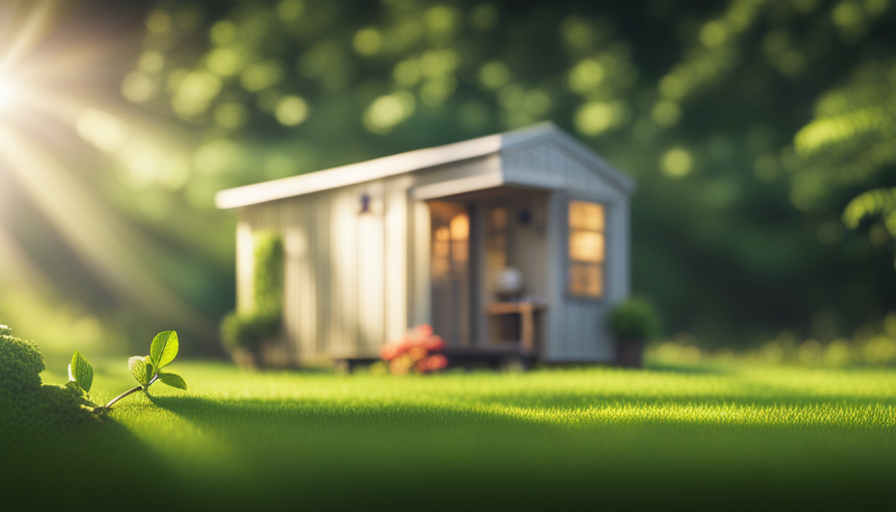
As the adage states, ‘Being cool isn’t only a mindset, it’s also a science.’ This is especially accurate when it comes to air conditioning for a small home. Given the constrained space and specific needs, it’s crucial to strike the perfect balance in cooling capability.
That’s where BTUs come into play. BTUs, or British Thermal Units, are a measurement of heat energy. In the realm of cooling, they indicate how much heat an air conditioner can remove from a space within an hour. Determining the ideal number of BTUs for your tiny house involves careful consideration of factors like size, layout, insulation levels, and even window placement.
In this article, we will delve into the world of BTUs and explore everything you need to know about cooling your tiny abode effectively. From assessing your specific needs to selecting the perfect air conditioner size and type, we’ll guide you through all the technicalities with precision.
So join me as we unravel this scientific puzzle and discover the best solutions for keeping your tiny house cool and comfortable all year round.
Key Takeaways
- Determining the ideal number of BTUs for a tiny house involves considering factors like size, layout, insulation levels, and window placement.
- Proper cooling with the right number of BTUs reduces humidity, improves air quality, and enhances energy efficiency.
- Evaluating square footage, insulation levels, windows, and doors helps determine BTU requirements.
- Choosing an air conditioner with a high EER or SEER rating saves energy.
Understanding BTUs and their significance in cooling a space
Do you know how many BTUs it takes to cool a tiny house? Understanding the significance of BTUs in cooling a space is crucial when it comes to assessing efficiency and understanding the benefits.
BTU, or British Thermal Unit, is a unit of measurement used to quantify the amount of heat energy needed to cool or heat a space. In the context of cooling, BTUs are used to measure the cooling capacity of air conditioners.
Assessing efficiency is important because it allows us to determine the most effective way to cool our tiny house without wasting energy. By understanding how many BTUs are required for our specific space, we can avoid purchasing an air conditioner that is either too small and struggles to effectively cool the area or too large and consumes unnecessary amounts of energy.
Moreover, knowing how many BTUs are needed helps us understand the benefits associated with proper cooling. A correctly sized air conditioner not only keeps our tiny house comfortable but also reduces humidity levels, improves indoor air quality, and enhances overall energy efficiency.
To assess the size and layout of your tiny house to determine BTU requirements, it’s essential to consider factors such as square footage, insulation levels, number of windows and doors, ceiling height, and local climate conditions. By taking these aspects into account, we can accurately determine the appropriate number of BTUs needed for efficient cooling.
Assessing the size and layout of your tiny house to determine BTU requirements
Assessing the size and layout of your cozy abode will help determine the appropriate amount of energy needed for optimal temperature control. When evaluating the space, it’s crucial to consider the square footage of each room in your tiny house. This will provide a baseline for calculating the BTU requirements necessary to cool your home effectively.
Additionally, take into account any open floor plans or high ceilings that may affect airflow and heat distribution.
Calculating the requirements involves multiplying the square footage by a factor specific to each type of room. For example, living rooms typically require 20 BTUs per square foot, while bedrooms may need only 10 BTUs per square foot. Keep in mind that insulation plays a significant role in maintaining desired temperatures, so be sure to assess its quality throughout your tiny house.
Furthermore, windows are another important factor that affects cooling needs. The number and size of windows can impact heat gain and loss significantly. Consider both their location and orientation when determining how much cooling power is required.
By carefully evaluating these aspects of your space and accurately calculating your BTU requirements, you can ensure efficient temperature control within your tiny house.
Transitioning into the next section about factors that affect cooling needs in a tiny house (such as insulation and windows), it’s vital to understand how these elements directly impact energy consumption and ultimately influence comfort levels without compromising efficiency.
Factors that affect cooling needs in a tiny house (insulation, windows, etc.)
Consider the quality of insulation and the size and location of windows when determining how to effectively control the temperature in your cozy abode. Insulation efficiency plays a crucial role in maintaining a comfortable indoor environment. It helps prevent heat transfer between the inside and outside of your tiny house, keeping it cool during hot weather. High-quality insulation materials such as spray foam or rigid foam boards with high R-values are recommended for optimal thermal performance.
Additionally, the size and location of windows can greatly affect cooling needs in a tiny house. Large windows allow more sunlight to enter, increasing heat gain during summer months. Installing low-emissivity (low-E) coatings on windows can help reduce solar heat gain while still allowing natural light into your space. Window shades or blinds also provide an effective way to block out direct sunlight during peak hours.
To further enhance cooling efficiency, proper ventilation options should be considered. This allows fresh air to circulate throughout your tiny house, reducing humidity and improving overall comfort. Ventilation options may include exhaust fans, window fans, or even a small ductless mini-split air conditioner with built-in ventilation capabilities.
Assessing insulation efficiency and considering window size and location are key factors in determining cooling needs for your tiny house. Proper ventilation options should also be taken into account to ensure optimal temperature control. Transitioning into the subsequent section about choosing the right air conditioner size and type for your tiny house requires careful consideration of these factors without compromising on comfort and energy efficiency.
Choosing the right air conditioner size and type for your tiny house
Ensuring optimal temperature control and maximum energy efficiency is crucial when selecting the ideal air conditioner for your cozy space. When it comes to cooling a tiny house, there are several factors to consider, including the size and type of air conditioner. To help you make an informed decision, here are some key points to keep in mind:
-
Energy-saving cooling options: Look for air conditioners that have a high Energy Efficiency Ratio (EER) or Seasonal Energy Efficiency Ratio (SEER). These ratings indicate how efficiently the unit uses electricity to cool your space.
-
DIY air conditioning installation: If you’re handy with tools and want to save money on installation costs, consider purchasing a window or portable air conditioner that you can install yourself. Just make sure it’s compatible with your tiny house’s windows and electrical system.
-
Proper sizing: It’s important to choose an air conditioner that is appropriately sized for your tiny house. A unit that’s too small will struggle to cool the space effectively, while one that’s too large will cycle on and off frequently, wasting energy.
-
Window vs. portable units: Window air conditioners are typically more efficient than portable ones since they vent hot air directly outside. However, if your tiny house doesn’t have suitable windows or if you want flexibility in moving the unit around, a portable option may be more suitable.
-
Noise level: Consider the noise level of the air conditioner before making a purchase. Since tiny houses have limited space, excessive noise from the unit could be bothersome.
By considering these factors and choosing the right size and type of air conditioner for your tiny house, you can ensure energy-efficient cooling options while maintaining optimal temperature control.
In the next section about "energy-efficient cooling options for tiny houses," we’ll explore additional strategies to keep your cozy haven comfortable without breaking the bank on electricity bills.
Energy-efficient cooling options for tiny houses
To maximize energy efficiency in your cozy space, you’ll want to explore the various options for cooling your tiny house. When it comes to energy-efficient cooling systems, there are a few options that can help keep your tiny house cool without consuming excessive power.
One option is to invest in a mini-split air conditioning system. These systems consist of an outdoor unit and one or more indoor units, allowing for individual temperature control in different areas of your tiny house. Mini-splits are known for their high energy efficiency ratings and can be a great choice for keeping your tiny house cool while minimizing electricity usage.
Another energy-efficient cooling option for tiny houses is solar-powered cooling systems. These systems use solar panels to generate electricity, which powers the air conditioner. By harnessing the sun’s energy, you can cool your tiny house without relying solely on the electrical grid.
Proper placement and installation of air conditioning units in a tiny house is crucial for optimal performance and energy efficiency. In the next section, we will discuss how to ensure that your air conditioning unit is placed correctly and installed properly to provide effective cooling while minimizing energy consumption.
[Transition: Now that we have explored energy-efficient cooling options, let’s move on to discussing the proper placement and installation of air conditioning units in a tiny house.]
Proper placement and installation of air conditioning units in a tiny house
When it comes to keeping your cozy space comfortable, the placement and installation of your air conditioning unit in a tiny house is crucial for optimal performance and energy efficiency.
Proper placement considerations should be taken into account to ensure that the AC unit can effectively cool the entire space. First and foremost, choose an area with good airflow, away from obstructions such as furniture or curtains. This will allow for better circulation of cool air throughout the tiny house.
Additionally, it’s important to install the unit at a height that allows for easy maintenance and cleaning. Placing it too high may make it difficult to reach for filter changes or repairs. On the other hand, installing it too low could impede airflow and reduce its cooling capacity.
Furthermore, proper insulation around the AC unit is essential to prevent air leakage and maintain energy efficiency. Seal any gaps or cracks around the unit using weatherstripping or foam insulation tape.
When considering the placement and installation of your air conditioning unit in a tiny house, take into account factors such as airflow, accessibility for maintenance, and proper insulation. These tips will ensure that your AC performs optimally while keeping your cozy space cool and comfortable without relying solely on air conditioning.
Additional tips for keeping your tiny house cool without relying solely on air conditioning
When it comes to cooling a tiny house, proper placement and installation of air conditioning units are crucial. However, relying solely on air conditioning can be costly and inefficient. That’s why it’s important to consider additional tips for keeping your tiny house cool without overusing your AC.
One effective technique is implementing energy-saving techniques. This includes using energy-efficient appliances and insulation materials that help keep the interior temperature stable. Additionally, installing window coverings such as blinds or curtains can block out direct sunlight and reduce heat gain.
Another strategy is utilizing natural ventilation. Opening windows strategically to create cross ventilation can promote airflow and decrease the need for constant air conditioning usage. Installing ceiling fans or portable fans can also aid in circulating cool air throughout the space.
By incorporating these energy-saving techniques and maximizing natural ventilation, you can minimize your reliance on air conditioning while still maintaining a comfortable indoor temperature in your tiny house.
Now, let’s delve into maintenance and troubleshooting tips for your tiny house cooling system to ensure its optimal performance all year round.
Maintenance and troubleshooting tips for your tiny house cooling system
Ensuring optimal performance of your cooling system in a small space can be a breeze with these maintenance and troubleshooting tips.
-
Regularly clean and replace air filters: Dirty filters can restrict airflow, reducing the efficiency of your cooling system. Clean or replace filters every one to three months.
-
Check for refrigerant leaks: Low refrigerant levels can cause your cooling system to work harder and less efficiently. Inspect for any signs of leakage, such as oil stains or hissing sounds, and promptly repair any leaks.
-
Keep the condenser unit clear: Remove any debris, leaves, or obstructions from around the outdoor condenser unit to ensure proper airflow. This will help prevent overheating and improve overall performance.
-
Inspect ductwork for leaks: Leaky ducts can lead to cooled air escaping before it reaches its intended destination. Seal any visible leaks using mastic tape or other appropriate sealing materials.
-
Schedule regular professional maintenance: A qualified technician should inspect your cooling system annually to identify potential issues early on and keep it running smoothly.
By following these maintenance tips and addressing common issues promptly, you can maximize the efficiency of your tiny house cooling system.
Now, let’s delve into cost considerations and budget-friendly cooling solutions for tiny houses without missing a beat.
Cost considerations and budget-friendly cooling solutions for tiny houses
To keep your small space comfortable without breaking the bank, let’s explore cost-effective cooling options for your compact home.
When it comes to tiny house cooling, it’s important to consider both the initial cost and long-term energy savings. One cost-effective cooling solution is a window air conditioner. These units are generally more affordable compared to central air conditioning systems and can effectively cool a small space. Additionally, they consume less energy, resulting in lower utility bills.
Another budget-friendly option is a portable air conditioner. These units provide flexibility as they can be moved from room to room as needed. They also tend to be more energy-efficient than window units, offering potential long-term savings on electricity costs.
In addition to choosing the right type of cooling system, there are several energy-saving tips you can implement to further reduce costs. For example, sealing any air leaks around windows and doors will prevent cool air from escaping and hot air from entering your tiny house. Installing blinds or curtains can also help block out sunlight and reduce heat gain.
By considering these cost-effective cooling solutions and implementing energy-saving tips, you can create a comfortable living environment in your tiny house while keeping expenses under control.
As we delve into exploring alternative cooling methods for eco-friendly and sustainable living in a tiny house, it’s important to find solutions that align with your budget and environmental values without compromising comfort or convenience.
Exploring alternative cooling methods for eco-friendly and sustainable living in a tiny house
Implementing environmentally-conscious cooling techniques in a compact living space can enhance sustainability and foster an eco-friendly lifestyle. When it comes to tiny houses, traditional air conditioning units may not be the most ideal choice due to their energy consumption and high BTU requirements. However, there are several eco-friendly cooling options available that can effectively cool a tiny house while minimizing environmental impact.
One option is using passive cooling techniques, such as strategic window placement, insulation, and natural ventilation. By designing the tiny house with well-insulated walls and windows that allow for cross ventilation, heat gain can be reduced, making it easier to maintain a comfortable indoor temperature without relying heavily on air conditioning.
Another sustainable cooling method is utilizing evaporative coolers or swamp coolers. These systems work by drawing in warm outside air through moist pads or filters and blowing out cooler air into the living space. This process relies on evaporation to lower the temperature, consuming less energy compared to traditional air conditioners.
Additionally, incorporating green roofs or reflective roofing materials can help reduce heat absorption from sunlight, further reducing the need for artificial cooling methods.
Exploring eco-friendly cooling options in a tiny house promotes sustainable living by minimizing energy consumption and reducing environmental impact. Passive cooling techniques, evaporative coolers, and reflective roofing materials are just some of the options available for those seeking an environmentally-conscious approach to staying cool in their compact living space.
Frequently Asked Questions
Are there any eco-friendly and sustainable cooling methods for tiny houses?
Oh, eco-friendly and sustainable cooling methods for tiny houses? Well, let me enlighten you with my technical prowess.
When it comes to keeping your tiny house cool without harming the environment, there are several innovative options to consider.
From solar-powered air conditioners to passive cooling designs that maximize natural airflow, these sustainable cooling solutions are the epitome of efficiency.
So say goodbye to traditional energy-guzzling systems and embrace a cooler future with these eco-friendly alternatives.
What are some cost considerations and budget-friendly cooling solutions for tiny houses?
When considering cost and energy efficient options for cooling a tiny house, it’s important to explore budget-friendly solutions.
Some considerations include the initial purchase cost of the cooling system, as well as ongoing operational expenses such as electricity consumption.
Opting for energy-efficient cooling methods like mini-split air conditioners or evaporative coolers can help reduce costs in the long run.
Additionally, utilizing natural ventilation and insulation techniques can further enhance energy efficiency and minimize expenses.
Are there any additional tips for keeping a tiny house cool without relying solely on air conditioning?
When it comes to keeping a tiny house cool without relying solely on air conditioning, there are several tips and strategies that can be effective. By implementing proper insulation, using reflective window coverings, and strategically placing shade-providing plants or awnings outside the house, you can reduce heat gain significantly.
Additionally, utilizing natural ventilation techniques such as cross ventilation and opening windows during cooler hours can help maintain a comfortable indoor temperature. These cost-effective methods promote energy efficiency while ensuring a cool living space.
What are some maintenance and troubleshooting tips for a tiny house cooling system?
Maintenance tips for a tiny house cooling system include regularly cleaning the air filters to ensure proper airflow and efficiency. Additionally, checking the condenser unit for any debris or obstructions is crucial.
Troubleshooting techniques involve inspecting the thermostat settings and ensuring they’re correctly calibrated. Furthermore, examining the refrigerant levels and electrical connections can help identify potential issues.
Regular maintenance and troubleshooting will keep your cooling system running smoothly and extend its lifespan.
How do insulation and windows affect the cooling needs of a tiny house?
Insulation and windows play a crucial role in determining the cooling needs of a tiny house. According to a study conducted by the Department of Energy, proper insulation reduces energy consumption for cooling by up to 30%.
High-quality windows with low-emissivity coatings can also prevent heat transfer, further optimizing energy efficiency.
By implementing these energy efficient cooling methods, such as insulation and windows, one can significantly reduce the BTUs required to cool a tiny house effectively.
Conclusion
In conclusion, when determining the BTU requirements for cooling a tiny house, it’s crucial to consider factors such as insulation and window quality. Choosing the right air conditioner size and type is essential for efficient cooling.
Interestingly, according to a study by the U.S. Department of Energy, using energy-efficient cooling options in a tiny house can save up to 30% on energy costs compared to traditional systems. By implementing eco-friendly alternatives and following proper maintenance practices, you can create a comfortable and sustainable living environment in your tiny house.
Hi, I’m Emma. I’m the Editor in Chief of Tiny House 43, a blog all about tiny houses. While tree houses are often associated with childhood, they can be the perfect adult retreat. They offer a cozy space to relax and unwind, surrounded by nature. And since they’re typically built on stilts or raised platforms, they offer stunning views that traditional homes simply can’t match. If you’re looking for a unique and romantic getaway, a tree house tiny house might just be the perfect option.
-

 Beginners Guides3 months ago
Beginners Guides3 months agoHow To Buy A Tesla Tiny House
-

 Energy Efficiency4 weeks ago
Energy Efficiency4 weeks agoBest Tiny Homes For Cold Climates
-

 Tiny House Resources (e.g., legalities, cost, insurance, FAQs)1 month ago
Tiny House Resources (e.g., legalities, cost, insurance, FAQs)1 month agoDo Tiny Homes Need Planning Permission?
-

 Beginners Guides3 months ago
Beginners Guides3 months agoFrom The Show Tiny House Nation How Many Keep Their Tiny House?
-

 Beginners Guides1 month ago
Beginners Guides1 month agoUsing a Climbing Net For Treehouse Construction
-

 Beginners Guides1 month ago
Beginners Guides1 month agoHow to Build a Treehouse Without Drilling Into the Tree
-

 Beginners Guides1 day ago
Beginners Guides1 day agoTiny House Nation Who Pays For The Houses
-
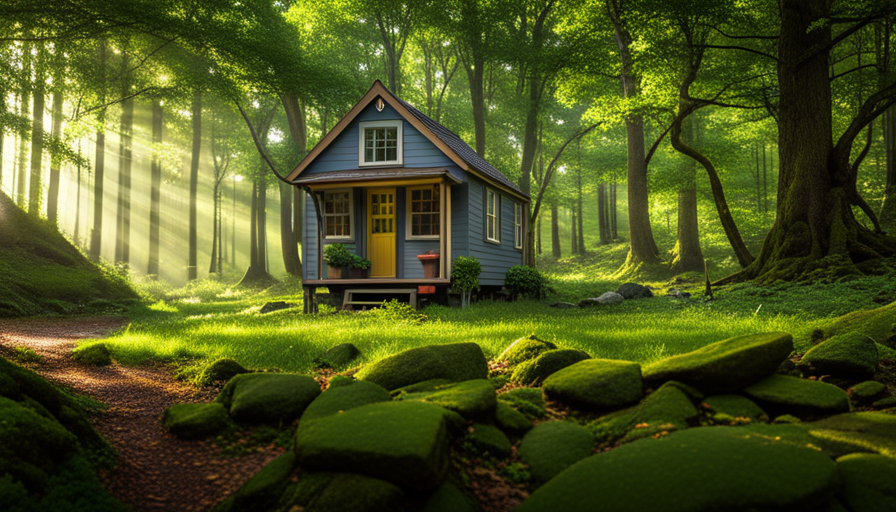
 Beginners Guides3 months ago
Beginners Guides3 months agoWhere To Park A Tiny House In New Jersey





